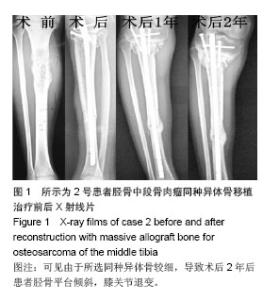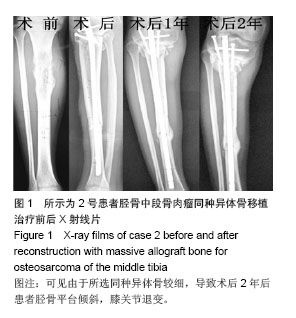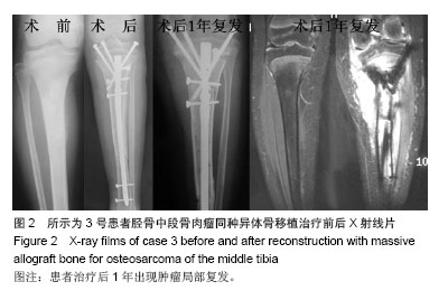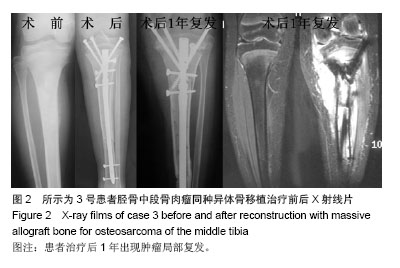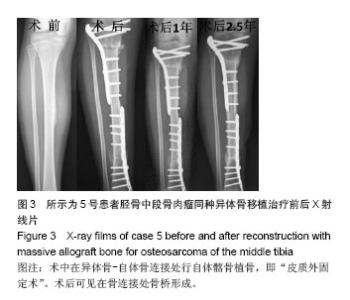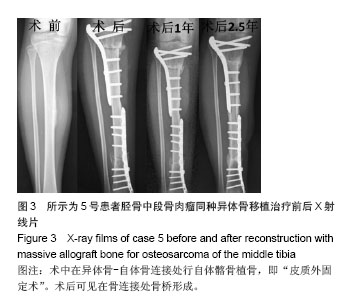| [1]Allison DC, Carney SC, Ahlmann ER, et al.A meta-analysis of osteosarcoma outcomes in the modern medical era.Sarcoma. 2012;2012: 704872.
[2]Hegyi M, Semsei AF, Jakab Z, et al. Good prognosis of localized osteosarcoma in young patients treated with limb-salvage surgery and chemotherapy. Pediatr Blood Cancer.2011;57(3): 415-422.
[3]Mangat KS, Jeys LM, Carter SR. Latest developments in limb-salvage surgery in osteosarcoma.Expert Rev Anticancer Ther.2011;11(2): 205-215.
[4]Tan PX, Yong BC, Wang J, et al. Analysis of the efficacy and prognosis of limb-salvage surgery for osteosarcoma around the knee.Eur J Surg Oncol. 2012;38(12):1171-1177.
[5]Jeon DG, Kim MS, Cho WH, et al. Pasteurized autograft for intercalary reconstruction: an alternative to allograft.Clin Orthop Relat Res.2007;456: 203-210.
[6]Poffyn B, Sys G, Mulliez A, et al. Extracorporeally irradiated autografts for the treatment of bone tumours: tips and tricks. Int Orthop.2011;35(6): 889-895.
[7]Noguchi M, Mizobuchi H, Kawasaki M, et al. An intramedullary free vascularized fibular graft combined with pasteurized autologous bone graft in leg reconstruction for patients with osteosarcoma.J Reconstr Microsurg. 2008;24(7): 525-530.
[8]Nonati D, Di Liddo M, Zavatta M, et al. Massive bone allograft reconstruction in high-grade osteosarcoma.Clin Orthop Relat Res. 2000;(377):186-194.
[9]Ramseier L E, Malinin T I, Temple H T, et al. Allograft reconstruction for bone sarcoma of the tibia in the growing child. J Bone Joint Surg Br. 2006;88(1): 95-99.
[10]牛晓辉,黄真.骨肉瘤的规范化疗[J].中国肿瘤临床. 2010(24期): 1390-1392.
[11]郭卫,杨荣利,汤小东,等.成骨肉瘤新辅助化学药物治疗的疗效分析[J].中华医学杂志.2004,84(14):1186-1190.
[12]Enneking W, Dunham W, Gebhardt M, et al. A System for the Functional Evaluation of Reconstructive Procedures After Surgical Treatment of Tumors of the Musculoskeletal System,. 1993;286:241-246.
[13]Poffyn B, Sys G, Van Maele G, et al. Radiographic analysis of extracorporeally irradiated autografts.Skeletal Radiol. 2010; 39(10): 999-1008.
[14]Gill J, Ahluwalia MK, Geller D, et al. New targets and approaches in osteosarcoma.Pharmacol Ther. 2013;137(1): 89-99.
[15]Pan K L, Chan W H, Ong G B, et al. Limb salvage in osteosarcoma using autoclaved tumor-bearing bone.World J Surg Oncol.2012;10: 105.
[16]Dick HM, Malinin TI, Mnaymneh WA. Massive allograft implantation following radical resection of high-grade tumors requiring adjuvant chemotherapy treatment. Clin orthop. 1985; 197:88-95.
[17]Jeys LM, Kulkarni RJ, Grimer SR,et al. Endoprosthetic reconstruction for the treatment of musculoskeletal tumors of the appendicular skeleton and pelvis. J. Bone Joint Surg. Am. 2008;90-A, 1265-1271.
[18]Aksnes LH, Bauer HC, Jebsen NL ,et al. Limb-sparing surgery preserves more function than amputation. A Scandinavian sarcoma group study of 118 patients. J. Bone Joint Surg. 2008; Br. 90-B, 786-794.
[19]Gebert C, Wesling M, Gotze C, et al. The modular universal tumour and revision system in endoprosthetic revision surgery. Int. Orthop. 2010;34(8),1261-1265.
[20]Mankin HJ, Doppelt S, Tomford W. Clinical experience with allograft implantation: the first ten years. Clin Orthop.1983; 174:69-86.
[21]许建波,孙洪瀑,肖砚斌,等.腓肠肌内侧肌瓣在胫骨上段恶性肿瘤切除保肢术中的应用[J].中国修复重建外科杂志,2007,21(4): 352-355.
[22]于秀淳,刘晓平,周银,等.腓肠肌内侧头肌瓣在胫骨上端恶性骨肿瘤保肢术中的应用[J].中国现代医学杂志,2003,13(6):128-129.
[23]Botter SM, Neri D, Fuchs B. Recent advances in osteosarcoma. Current opinion in pharmacology. 2014; 16C: 15-23
[24]Schuetze SM.chemotherapy in the management of osteosarcoma and ewing's sarcoma. J Natl Compr Canc Netw. 2007;5(4):449-455.
[25]Alman BA, De Bari A, Krajbich JL. Massive allografts in the treatment of osteosarcoma and Ewing sarcoma in children and adolescents. J Bone Joint Surg.1995;77-A:54-64.
[26]Kohler R, Lorge F, Brunat-Mentigny M, et al. Massive bone allografts in children. Int Orthop 1990;14:249-253. |


